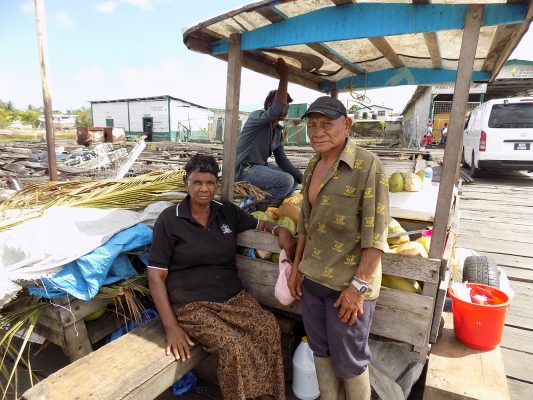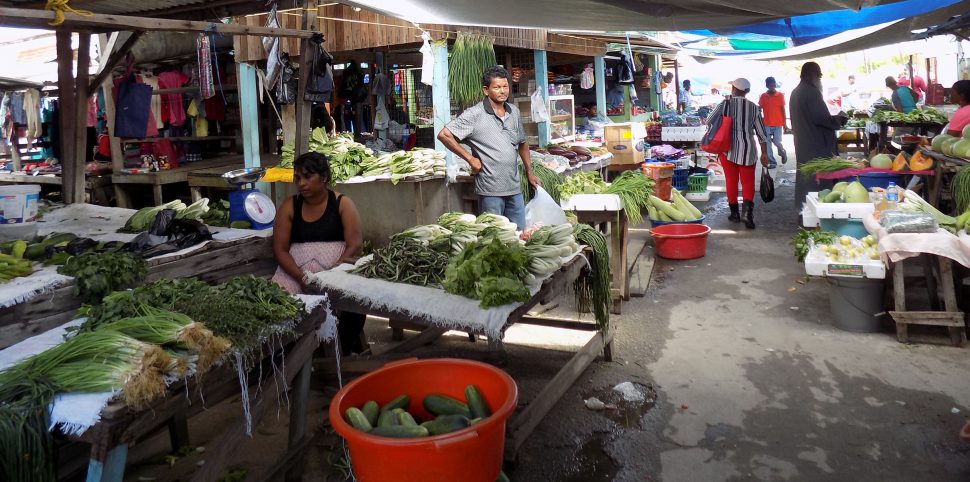If you visit Parika stelling on any Friday afternoon and if you are able to spend the entire weekend there, it is not just the range of commercial activity that will hold your attention but the manner in which a host of influences converge and the people that come from the far-flung communities to gather there, their livelihoods dependent on participating in the activities.
What is now sometimes called Parika Market is a fenced off, concreted area at Hydronie, a few hundred yards from the Parika Stelling. It is the successor to the controversial trading arrangement that had obtained at the Parika Stelling itself. Outside the fenced area there is a sign marked Hydronie Market and inside the fence there are probably about two hundred stalls.
Hydronie is a typical market as far as the hustle and bustle is concerned. To find its essence, however, you have to rise above the ruckus of the trading. That will afford you insightful access to a vigorous socio-cultural undercurrent comprising the myriad influences that converge and the hectic hustle by various people from different, far-flung communities to seize the economic opportunity that it offers.

On Fridays they begin to arrive from early in the day… farmers and wholesalers with their ‘loads’ of all sorts; fruit, vegetables and meats, among other things, arrive from the Back Dams of Parika itself, from Bonasika, Northern Hog Island, Leguan, Wakenaam and from villages along the west coast of Demerara, each with their separate vested interest in the weekend’s trading activity.
Last weekend when we were there, there was farm produce in abundance. Plantains, ground provision, bananas, peppers, pumpkin, eschallot, watermelon, coconut and calaloo. Some of the vendors (in some instances their parents before them) have been trading here for decades, making the journey mostly by river, in some instances by road. Most of them are bona fide farmers; there are traditional wholesalers here too, seasoned entrepreneurs who would buy an entire crop of one fruit or vegetable or the other then take their goods to Parika to compete with the farmers there.
We spoke to some of the traders and the consensus of opinion was that these are tough times. A short while ago shoppers from communities along the West Coast Demerara were a vital part of the ‘engine’ that powered the Hydronie trading area. That was before the closure of the Uitvlugt Estate. It is the same, we were told, with the gold miners who had previously been travelling from Bartica much more frequently and in greater numbers to buy ‘in bulk’ to feed the men who kept their operations going. These days, they come in smaller numbers and the ‘jousting’ among the traders at Hydronie to get their attention and their patronage has become more intense. There is no doom and gloom here though there is an unmistakable recognition that these are much more difficult times.
The vendors arrive at Parika on Friday evenings, mostly by ferry. A great many of them travel from Supenaam. It’s far cheaper by ferry…$360 as against $1300 by speedboat. On Friday there was a farmer who had done the half hour trip to Parika from Hogg Island in his own speedboat. Trading begins on Friday evening, intensifies on Saturday and extends into Sunday, up to about 15:00 hours. Afterwards there is a sort of a ‘happy hour’, a wind down that sees the prices of perishables fall to the floor. The opportunity brings its own clique of buyers to the market. Penny-pinching housewives, mostly, always on the lookout for ‘bargains’. Afterwards, many of the vendors head for Parika Stelling en route to Supenaam and Leguan. The others make their way to their respective homes in the river by boat. It is a precarious ‘hit or miss’ existence and at the end of every trading weekend there are losses to be counted.
It is far from uncommon for the sellers to return home with much of their goods unsold. Bulky produce like coconuts are often simply left where they were offloaded for trading a few days earlier. There is the perpetual presence of opportunists ready to make off with goods that must be left unattended.
After the ‘market’ had almost spent itself we spoke with the sellers. It had not been a good trading weekend but these are people who have learnt to ‘accept and bless’. Herman De Freitas had brought 150 watermelons to Parika from Greenwich Park. He had sold 40 and was returning home with the remainder. Ishwar Sattaur sells fruit and vegetables at both the Hydronie and Leonora market. He too had had a disappointing weekend. Pepe and Indira are a farming couple from Leguan. They had had better luck last weekend. Most of the calaloo and bora that they had brought to the market had been sold. Next time around, fortunes may swing in different directions.
At the end of the weekend’s trading, the extent of the inevitable spoilage and waste is readily apparent. In most cases it is simply not cost effective to return to distant homes with large amounts of unsold food. The obvious solution would be some sort of storage facility, probably funded by government, which the farmers can access to keep their unsold produce. Perhaps, too, excess fruit and vegetables could be exploited by the agro processing sector.
The volume of ‘left overs’, mostly fruit and vegetables from the weekend’s trading was striking. The sellers are used to this. There are times when the glut of farm produce inevitably drives prices down. Last weekend huge watermelons could be had for $400 each, pineapples at $300 each and yams at $200 per pound. We observed the persistent but mostly unsuccessful efforts of one diminutive female vendor to ‘sell off’ squash remaining from the weekend’s trading at three for $100. As the window on the ‘happy hour’ began to close, it was pretty obvious that she was making little headway.
Beris Washington is a speedboat captain who ferries passengers between Bartica and Parika. He too is caught up in the ebb and flow of the ‘local’ economy. The Bartica-Parika trip lasts between sixty and sixty-five minutes. The fortunes of the ‘gold bush’ have impacted heavily on river transportation. The miners from the Cuyuni no longer travel between Bartica and Parika as frequently. Not many moons ago, when gold prices were higher, the speedboat operators could rely on making at least one trip per day. These days it can be as bad as a single trip in two weeks. There are fifty-three registered speedboats plying the route and when the ‘turn’ system,
overseen by the Bartica Speedboat Association, is taken account of, it is no surprise that you have to wait a proverbial ‘year and a day’ to have your ‘turn’ come around. The boats that ply the route are outfitted with two 200-horse power engines and can accommodate between twenty-two and twenty-six people. The captain is paid around $15,000 per trip while the bow man takes home $13,000. Some crews are lucky enough to operate two boats, a circumstance which affords them two ‘turns’.
Claude James and Kuntie Balram operate a 35-acre farm at Northern Hog Island. They use their own 29-foot boat to do the half hour trip to Parika with their produce… ground provision, plantain, banana and coconut. These days they may spend up to three or four days at Parika, sleeping in a shack by the seaside. Those are the times when they opt to remain near the trading area rather than return home with unsold goods.
James is an Amerindian originally from Kamarang in the Upper Mazaruni. His wife is East Indian, originally from Leguan. They employ one farm hand. The little that the two have to say epitomises the ebb and flow of fortunes that characterises the ‘hustle’ that takes place at the ‘market’ at Hydronie. They don’t talk much about change. It is as if they have resigned themselves to a life that will always have its humps and challenges and that it is only a matter of whose turn it is to have rain fall at their door.






